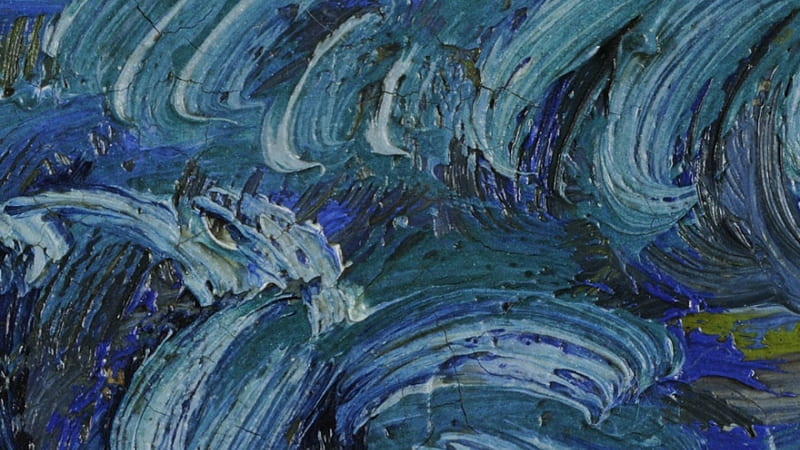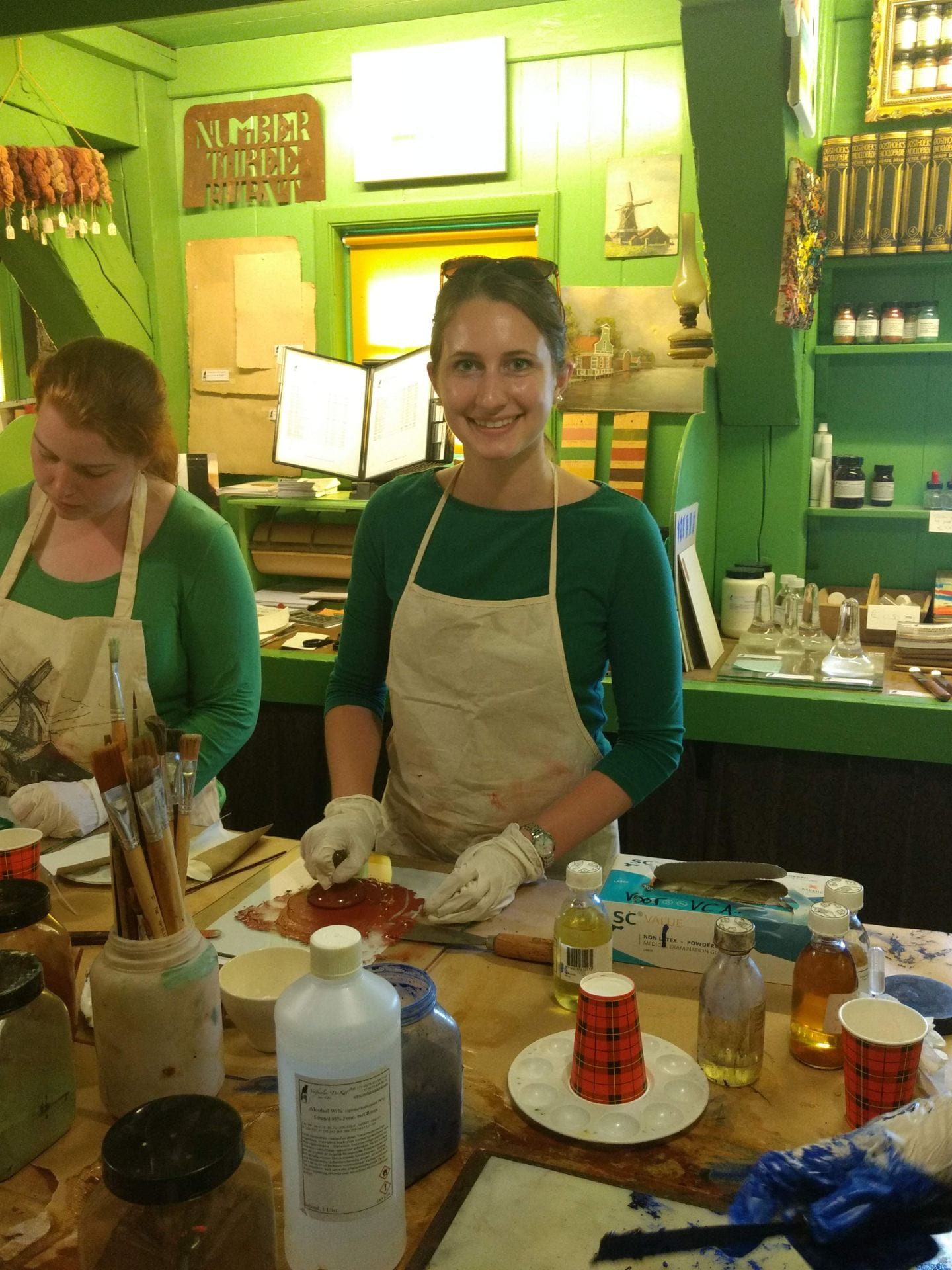A COLORFUL JOB
By: Rebecca Harmon

Chemical engineer Rebecca Harmon on what it’s like working on art conservation
As I stand in an emerald green room beneath a windmill in Zaanse Schans, Netherlands, wearing a canvas smock and disposable gloves, I am front-row to a demonstration of how artists traditionally made oil paints. The craftsman dumps a mound of ultramarine blue pigment on a marble slab and hollows out a hole in the center, in which he pours an ounce or so of linseed oil. He takes his muller, a dark bell-shaped grinding stone, and begins to work the powder into the yellow-tinged oil. A rich, glossy blue paste emerges as he moves the stone in a figure-eight pattern on the slab. He adds a mere drop of water to thicken the paste into the familiar consistency of oil paint. Two drops of solvent will help the paint glide onto a canvas with the stroke of a brush.
I was four weeks into my two-month stay in Amsterdam and just half a year into my new research project, and my head was spinning. I was still trying to find my place among the jargon, organic chemistry, and art history that comprises the field of cultural heritage science, which studies and maintains physical objects (including paintings) passed down from generation to generation. Little did I imagine that it would take me standing in that small, colorful room to find my footing between engineering and art.
Humans have been painting for more than 40,000 years and using oil paint widely for only 500. At the start, artists and laborers mixed paint by hand. It wasn’t until the advent of large-scale production in the 19th century that paints were churned by a vat and distributed in tin tubes. Industrialization also produced the chemical engineer, a scale-up of the classic chemist, to meet society’s new demands. Many found their occupational homes in large oil refineries and chemical plants. What about a chemical engineer in an art studio, working to protect and preserve historic art? That’s me, and only a handful of others in the world.
I study the chemistry in oil paints. Knowing more about why and how paint dries and behaves over time can help predict what a painting might look like in 10, 50, or 100 years. This information also helps art conservators test how a painting might respond to a change in temperature, humidity, or cleaning solution and probe its restoration timeline. The goal is to slow the inevitable breakdown of artworks that offer a window into the lives, experiences, and stories of different cultures and times in history, so future generations can appreciate their cultural heritage.
A Pretty Problem
Oil paintings are a classic chemical engineering problem, but a little prettier. As your eyes zoom in on a painting hanging on the wall, you first see the overall colors that make the picture come to life, then the detail of the brushstrokes piecing the image together. If you could zoom a little closer, you would see a layer of dust and dirt that passively settled on the surface over the years. Below the dust is the oil paint that appears dry to the touch with speckles of colored particles scattered throughout. You would now be seeing things smaller than the width of a human hair, so small yet so vibrant. As you zoom in 100 times more, you begin to see molecules made of carbon, oxygen, and hydrogen atoms wiggle around. When the artist first added the paint to the canvas, oil molecules made up of fatty acids freely drifted around in the thin layer. As oxygen from the air reached the oil, the molecules started linking together, like holding hands to form longer and longer chains. The molecules would intertwine and mix until they couldn’t wiggle around as much. At that point, they made the paint dry to the touch. Over time, some of the links would break and form new ones or release smaller molecules that would float off into the air. What you’re looking at with your zoomed-in eyes is chemistry that never stops, chemistry that happens in a colorful, rectangular reactor hanging on a wall.
A Web of Reactions
In high school chemistry, the simplest reaction you learn is A -> B. One molecule transforms into another. Perhaps B could then transform into C, C into D and E, E reacts with A forming F, and so on. Now imagine tens of thousands more chemical species and 1 million more reactions. That’s what is happening in this unassuming, decorative reactor. The complex system is affected by temperature, humidity and its different pigments, so I employ a computer to do the heavy lifting.
In our research group at Northwestern University, we use what’s called automated reaction network generation to automatically build out a web of reactions. To do so, we translate the starting chemicals into matrices of 1s and 0s that describe how every atom connects. We then use a simple matrix to make and break bonds that describe a chemical reaction. New, unique species are made and added to the list to react, growing from A -> B to a massive spider web. We use experimental data and thermodynamic approximations to calculate the speed of the millions of reactions on-the-fly. The computer generates a set of ordinary differential equations from the web and calculates how chemical species’ concentrations change over time. We then use this model to paint a picture of the condition of an artwork and help guide conservators as they make treatment decisions.
Working in a humanities-centered field such as cultural heritage often makes me feel like a fish out of water. The conversations focus on intention, emotion, and context instead of engineering’s numbers, equations, and data tables. Standing in that small, green room beneath a windmill reminded me of the need for chemical engineers in the most surprising places. Even though I don’t wear a hardhat or an artist’s beret, I get to preserve art and cultural heritage by watching “paint dry” on a computer.

